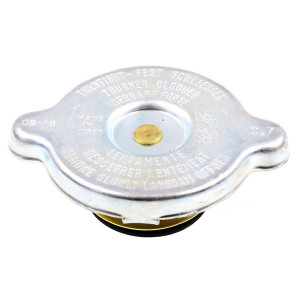Radiator cap
Aixam 400i , 500i , 500ut , 600i , A540 , A550 / Microcar MC1 , MC2 / Ligier 162 , Ambra / Chatenet Media…
New
In stock
€7.42
The radiator cap is an element often under-estimated but essential for the proper functioning of the cooling circuit of a car-free car. It is not only used to close the radiator: it also regulates the pressure of the system, prevents the cooling liquid from evaporating and ensures that the motor operates at the correct temperature. A worn or defective plug can cause liquid losses, overheating and significantly reduce the life of the engine.
The radiator cap acts as a safety valve. It is calibrated to maintain a precise pressure in the cooling circuit. This pressure allows cooling liquid not to boil too early, even at high temperatures, which improves the cooling efficiency.
If the pressure becomes too high, the radiator cap passes the excess to the expansion tank. This function protects the radiator and hoses against a break that could lead to significant leakage.
A cap in good condition also prevents the air from entering the circuit. The presence of air can create bubbles and cause defusing the water pump, resulting in motor overheating.
A plug that no longer maintains the pressure can let the liquid flee, resulting in too low level and a risk of fast overheating.
An ill pressurized circuit fails to maintain the liquid in circulation correctly. The boiling point is lower, the engine heats up faster and can undergo significant damage.
The presence of air in the circuit promotes the formation of bubbles and can damage the water pump, causing ineffective cooling and gurgling noises in the system.
If you observe traces of liquid or dry deposits around the radiator cap, it is probably that it is no longer waterproof.
A plug that no longer maintains the pressure can let the liquid escape, sometimes without apparent leakage. Watch for your level regularly.
If your hoses are constantly under excessive pressure or softly, the radiator cap may be involved. Its role is to balance the pressure in the circuit.
A faulty radiator cap does not allow the circuit to operate at the correct pressure. Result: the liquid end too early and the engine temperature climbs quickly.
Check that the plug seal is in good condition, there is no crack or corrosion on the metal parts and the spring is functional.
The radiator cap is an inexpensive room. It is recommended to replace it regularly (every 2 to 3 years or when replacing the radiator) to ensure optimal operation.
A faulty plug can damage the expansion tank by putting it under too high pressure. When replacing, ensure-You that the entire system works properly.
Each cap is designed for specific pressure (expressed in bar or PSI). Use a plug with incorrect pressure can damage the radiator or reduce cooling efficiency.
Check the diameter and type of fixing of the cap: screwed or bayonet. A badly adapted plug will not be waterproof and will endanger the entire system.
Focus on the caps with quality joints and robust springs to ensure long-term sealing and precise pressure regulation.
If your problem does not only concern the plug but your engine radiator is damaged or fleeing, see our full category: Car engine drum without license.
One radiator cap In good condition is a key element to preserve the correct operation of the cooling circuit of your car-free car. Replace-The regularly, check its sealing and monitor the coolant level to prevent overheating and extend the life of your engine.
Also find our community on our forum Avenir VSP !
